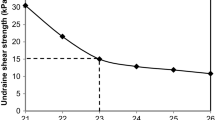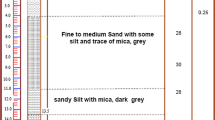Abstract
Stone columns are used as a ground improvement technique, and they not only enhance the bearing capacity and reduce the settlement, but also serve as a primary function of reinforcement and drainage. Wrapping the stone columns with geosynthetic materials makes ordinary stone column (OSC) stronger and stiffer by enhancing its performance. Ring footings are more often provided for structures such as storage tanks and bridge piers. Stone column is generally used with square, rectangular and circular footings. The idea of using ring footing with encased stone column is very popular nowadays. By using geosynthetic-encased stone column (GESC) with combination of ring footing, more increase in bearing capacity and reduction in settlement are achieved as compared to OSC. Based on the experimental results, pressure–settlement response of the stone column-reinforced clay was studied. This paper also presents the subgrade modulus aspect of geosynthetic-encased stone column-reinforced clay bed The aim of this paper is to study the effect of different parameters such as the number of columns, length of column, diameter of column and the effect of encasement provided on OSC and GESC on bearing capacity and on subgrade modulus. The variation of bearing capacity ratio and settlement are also reported for different parameters. The experimental data were further used for regression analysis to fit the equation for bearing capacity of the improved soft clay bed. Thus, it was concluded that with the increase in the number of columns, length and diameter of column, bearing capacity and subgrade modulus of reinforced clay have increased.


































Similar content being viewed by others
References
Bardet JP et al (1995) The great Hanshin earthquake disaster. In: Preliminary Investigation Report. Department of Civil Engineering University of Southern California, Los Angeles
Lee JS, Pande GN (1998) Analysis of stone-column reinforced foundations. Int J Numer Anal Methods Geomech 22(12):1001–1020
Ambily AP, Gandhi SR (2004) Experimental and theoretical evaluation of stone column in soft clay. In: ICGGE-2004, vol 25, pp 201–206
Van Impe WF (1989) Soil Improvement Techniques and Their Evolution. Balkema, Rotterdam
Murugesan S, Rajagopal K (2006) Geosynthetic-encased stone columns: numerical evaluation. Geotext Geomembr 24:349–358
Lo SR, Zhang R, Mak J (2010) Geosynthetic-encased stone column in soft clay: a numerical study. Geotext Geomembr 28:292–302
Gniel J, Bouazza A (2009) Improvement of soft soils using geogrid encased stone columns. Geotext Geomembr 27(3):167–175. https://doi.org/10.1016/j.geotexmem.2008.11.001
Murugesan S, Rajagopal K (2010) Studies on the behavior of single and group of geosynthetic encased stone columns. J Geotech Geoenviron Eng ASCE 136(1):129–139
Ghazavi M, Afshar JN (2013) Bearing capacity of geosynthetic encased stone columns. Geotext Geomembr 38:26–36
Jamshidi Chenari R, Karimpour Fard M, Jamshidi Chenari M et al (2017) Physical and numerical modeling of stone column behavior in loose sand. Int J Civ Eng 3:1–14
Gniel J, Bouazza A (2010) Construction of geogrid encased stone columns: a new proposal based on laboratory testing. Geotext Geomembr 28:108–118
Fisher K (1957) Zur Berechnung der setzung Von Fundamenten in der form einer Kreisformigen Ringflache. Der Bauingenieur 32(5):172–174 (in German)
Kumar J, Ghosh P (2005) Bearing capacity factor Nγ for ring footings using the method of characteristics. Can Geotech J 42(5):1474–1484
Benmebarek S, Remadna MS, Benmebarek N, Belounar L (2012) Numerical evaluation of the bearing capacity factor of ring footings. Comput Geotech 44:132–138
Saha MC (1978) Ultimate bearing capacity of ring footings on sand. M. Eng. Thesis. University of Roorkee, Roorkee
Saran S, Bhandari NM, Al-Smadi MMA (2003) Analysis of eccentrically–obliquely loaded ring footings on sand. Ind Geotech J 33(4):422–446
Sharma V, Kumar A (2017) Strength and bearing capacity of ring footings resting on fibre-reinforced sand. Int J Geosynth Ground Eng 3:9. https://doi.org/10.1007/s40891-017-0086-6
Moayed RZ, Rashidian V, Izadi E (2006) Evaluation on bearing capacity of ring foundations on two layered soil. World Acad Sci Eng Technol 61:1108–1112
Dash SK, Reddy PD, Raghukanth STG (2007) Subgrade modulus of geocell-reinforced sand foundations. Proc Inst Civ Eng Ground Improv 160(GI1):1–9
Bora MC, Dash SK (2014) Regression model for floating stone column improved soft clay. In: Proceedings of Indian Geotechnical Conference IGC-2014 December 18–20, Kakinada
Yadav JS, Tiwari SK (2016) Behaviour of cement stabilized treated coir fibre-reinforced clay-pond ash mixtures. J Build Eng 8:131–140. https://doi.org/10.1016/j.jobe.2016.10.006
Yadav JS, Tiwari SK (2017) Effect of waste rubber fibres on the geotechnical properties of clay stabilized with cement. Appl Clay Sci 149:97–110
Yadav JS, Tiwari SK (2017) Evaluation of the strength characteristics of cement stabilized clay–crumb rubber mixtures for its sustainable use in geotechnical applications. Environ Dev Sustain. https://doi.org/10.1007/s10668-017-9972-2
Yadav JS, Tiwari SK (2017) A study on the potential utilization of crumb rubber in cement treated soft clay. J Build Eng 9:177–191
Yadav JS, Tiwari S, Shekhwat P (2018) Strength behaviour of clayey soil mixed with pond ash, cement and randomly distributed fibres. Transp Infrastruct Geotech. https://doi.org/10.1007/s40515-018-0056-z
ASTM Standard D 6913, 2004 (e2) (2004) Standard test methods for particle-size distribution (gradation) of soils using sieve analysis, vol 04.09. ASTM International, West Conshohocken
ASTM D 4221-99, 1999 (2005) Standard test method for dispersive characteristics of clay soil by double hydrometer, vol 04.08. ASTM International, west Conshohocken
ASTM Standard D 0854, 2006 (2006) Standard test methods for specific gravity of soil solids by water pycnometer, vol 04.09. ASTM International, West Conshohocken
ASTM D 4318, 2005 (2005). Standard test methods for liquid limit, plastic limit, and plasticity index of soil, vol 04.08. ASTM International, West Conshohocken
ASTM D 2487, 2006 (2006) Standard practice for classification of soils for engineering purposes (Unified Soil Classification System), vol 04.08. ASTM International, West Conshohocken
ASTM D4595 (2011) Standard test method for tensile properties of geotextiles by the wide-width strip method. ASTM International, West Conshohocken
Kumar V, Kumar A (2018) An experimental study to analyse the behavior of piled-raft foundation model under the application of vertical load. Innov Infrastruct Solut 3:35. https://doi.org/10.1007/s41062-018-0141-8
Debnath P, Dey AK (2017) Bearing capacity of geogrid reinforced sand over encased stone columns in soft clay. Geotext Geomembr. https://doi.org/10.1016/j.geotexmem.2017.08.006
IS: 15284 (Part1-2003) Design and construction for ground improvement—guidelines. Part 1: Stone column ICS 93.020
Acknowledgement
I would like to thank my supervised Prof. Vikas Kumar, Civil Department, MMMUT, Gorakhpur, for his direction and consistent support throughout the course of my research work. I genuinely acknowledge and esteem his regarded direction and support from the earliest starting point to the end of my research paper.
Author information
Authors and Affiliations
Corresponding author
Ethics declarations
Conflict of interest
On behalf of all authors, the corresponding author states that there is no conflict of interest.
Rights and permissions
About this article
Cite this article
Verma, S., Kumar, V. & Priyadarshee, A. An experimental test study on ring footing resting on clay bed reinforced by stone column. Innov. Infrastruct. Solut. 3, 64 (2018). https://doi.org/10.1007/s41062-018-0169-9
Received:
Accepted:
Published:
DOI: https://doi.org/10.1007/s41062-018-0169-9




